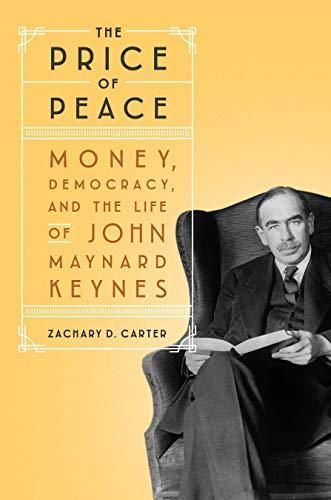HuffPost reporter Zachary D. Carter’s biography of that titan of economics, John Maynard Keynes, eschews the theoretical to recount a human journey of intense emotion and moral combat. Keynes emerges as a fascinating, contradictory figure.

A Towering Figure
HuffPost senior reporter Zachary D. Carter’s rigorous reporting and compassionate insights led The Wall Street Journal to call this work “a timely, lucid and compelling portrait of a man whose enduring relevance is always heightened when crisis strikes.” The New York Times described it as an “outstanding new intellectual biography of John Maynard Keynes that moves swiftly along currents of lucidity and wit.” Both reviewers specifically praise Carter’s clarity, because he makes complex economic theory and policy accessible to readers who know little of economics but rightfully find Keynes fascinating.
Those drawn to Keynes’s thinking might also peruse The Deficit Myth by Stephanie Dalton or The Essential Keynes, edited by Robert Skidelsky. Neither links Keynes’s life, work and philosophy together as Carter does, but each sheds light on the great economist’s most influential ideas.
International Reputation
Keynes, born in 1883, loved art and cultural pursuits, and he was a member of the artistic and literary Bloomsbury Group. “It was the finer things in life that mattered most to Keynes,” the author writes. “The task for economists was to determine how many people could enjoy them.” Carter tells how Keynes, though gay, married a Russian ballerina. She epitomized, Carter explains, the “international cultural milieu” to which Keynes believed the world should aspire.
Seconded to run British finances during World War I, Keynes joined the peace negotiations at Versailles. Carter well describes Keynes’s concerns about France’s desire to humiliate Germany. In 1919, Keynes wrote the bestselling The Economic Consequences of the Peace, which outlines Germany’s mass psychology and forecasts the inflationary and political repercussions of reparations. Carter argues that this established Keynes’s reputation for linking economic practices to political perils.
Dangers of Deflation
In 1925, UK officials thought returning the pound sterling to the gold standard would help regain British glory. But Keynes, Carter discloses, recognized that an upward revaluation in the pound would lead to deflation in the British economy. Few heeded his text, The Economic Consequences of Mr. Churchill, but Carter tells how Keynes accurately predicted the recessionary conditions that fueled periodic industrial unrest.
Monetary disruptions – inflation and deflation – had disparate effects on different segments of society.
Zachary D. Carter
Carter explains that Keynes argued for stable prices rather than for stable exchange rates, a stance that has since become the norm. Keynes also warned that the pound returning to the gold standard would permit the US Federal Reserve to dictate British economic conditions. He contrasted this with the pre-WWI era, when Great Britain recirculated its purchasing power by lending to enterprises abroad. Carter again and again notes that history often proved Keynes right.
Keynes Ignites Debate
British politicians sought Keynes’s advice after the 1929 stock market crash. His 1930 A Treatise on Money features historical examples of the perils of deflation and of the prosperity resulting from an accommodative monetary environment. Carter notes Keynes’s attacks on laissez-faire economics and on the notion that thrift is good, as well as the crucial Keynesian position that states create money, markets and economies, and that these require government involvement.
By reaching back to ancient history, A Treatise on Money had opened the door to new thinking. If societies had always needed to actively manage their monetary systems to secure prosperity, then maybe markets didn’t work the way economists believed they did.
Zachary D. Carter
In 1936, Keynes aimed The General Theory of Employment, Interest and Money at professional economists to gain influence and prestige. Carter emphasizes that, though the book is notoriously dense, it shaped a generation of economists. Macroeconomics was born out of Keynes’s focus on the impact and technicalities of saving, investing and spending – how the act of saving money takes cash out of circulation, and how investments in buildings or products represents savings re-entering the economy. Carter also breaks down Keynes’s liquidity preference theory, which explains how, during an economic depression, people might hoard their money and not sink it into risky enterprises, regardless of how low interest rates are. Carter regards this Keynesian insight as groundbreaking: Money is the link between past and future economic activity that could rupture at any time.
New Deal Policies and World War II
President Franklin D. Roosevelt, Carter reports, didn’t seek the noted economist’s advice, but Keynes nonetheless influenced the US administration. The success of the New Deal and of government borrowing for the war vindicated Keynes. The United States’ academic profession, Carter tells us, took mainstream economics in a new, Keynesian direction.
During WWII, Keynes’s How to Pay for the War analyzed macroeconomics and inflation. He proposed compulsory deferred savings accounts for people in a tightening labor market, and he contended that companies should pay higher taxes to help with inflation and reduce war profits. US businesspeople criticized the Keynesian economists trying to stop war inflation through price and wage control measures. “Keynes argued,” according to Carter, “that the ideal borrower of the moment was the federal government.”
The Bretton Woods Conference
Keynes’s criticisms of the deflationary mechanisms and gold hoarding by creditor countries influenced the 1946 Bretton Woods conference. Carter writes that Bretton Woods, after which the US dollar became the center of international finance, was Keynes’s “final opportunity to breath political life into the beautiful abstractions he had spent a quarter of a century dreaming up to save humanity from itself.”
Keynes died in 1946, but Keynesian macroeconomics continued to hold sway for the next several decades. Carter concludes that Keynes eradicated the classical economics of balanced budgets and sound money. He sought to make economies work for people and to prevent hardships that might spur unrest and revolution.
A Daring Approach
Carter takes on a Herculean task: explaining the intellect, vast cultural appetite and worldwide influence of a towering figure in a field that few laypersons understand. Carter finds in Keynes sufficient mystery, contradictions and glamour to contextualize Keynes’s thought and its impact on world economies. This is a daring approach, and Carter makes it sing. Even those who know nothing of Keynes or his theories will be captivated.




